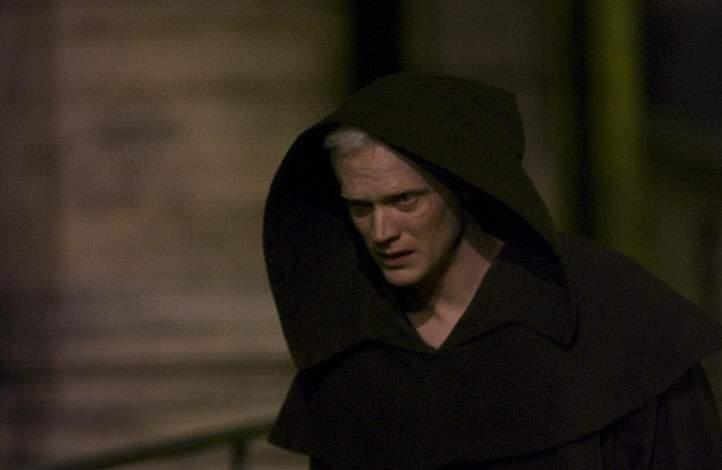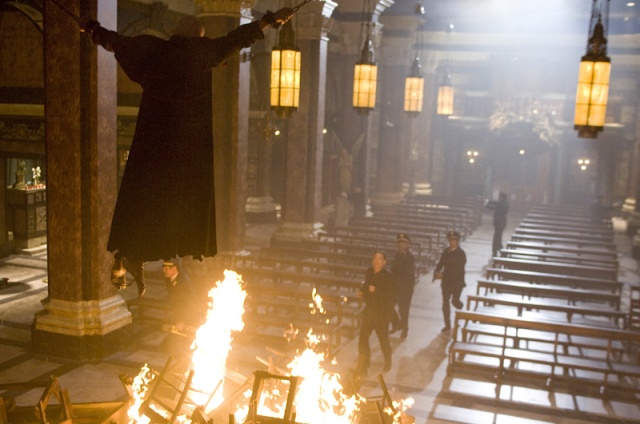 This big-budget, Hollywood studio adaptation of the best-selling novel by Dan Brown turns out to be a murky, plodding affair, whose pompous aspirations toward being serious undermine most of the entertainment value of what is, underneath the gloss, a simple-minded hokey thriller. Although it is interesting enough to hold your attention, and even comes to life in places, it is ultimately too long, too stilted, and — occasionally — too ridiculous to be reckoned a success.
This big-budget, Hollywood studio adaptation of the best-selling novel by Dan Brown turns out to be a murky, plodding affair, whose pompous aspirations toward being serious undermine most of the entertainment value of what is, underneath the gloss, a simple-minded hokey thriller. Although it is interesting enough to hold your attention, and even comes to life in places, it is ultimately too long, too stilted, and — occasionally — too ridiculous to be reckoned a success.
THE STORY
In case you haven’t heard, the film follows Robert Langdon (Tom Hanks), an art historian and professor who is summoned to help the police investigate a murder at the Louvre museum in Paris. It turns out Langdon is actually a suspect. He hooks up with a policewoman (Audrey Tautou), who coincidentally happens to be the murdered man’s granddaughter. They follow a series of clues that leads them to seek the advice of an expert who has dedicated his life to studying the Holy Grail (Ian McKellen). Meanwhile, they are pursued by the real murderer, an albino monk (Paul Bettaney), who is working for a Bishop (Alfred Molina) of the conservative believe Catholic organization Opus Dei, which is seeking to find and destroy evidence that Jesus was really married to Mary Magdalene.
The convoluted plot is pretty much incredible and nonsensical, as it was in the novel. The difference is that Brown had a lot more space to rationalize his incidents and layer on heavy doses and psuedo-historical bullshit that made the whole story feel as if something important really was going on. The screenplay by Akiva Goldsman has to cut way down on the exposition but still leave in enough to leave some semblance of clarity. The result is the worst of both worlds: a storyline that feels both over-burdened with exposition and filled with gaps in logic.
Despite his obviously failings as a novelist (one-dimensional characters, lame dialogue, bad research presented as established fact), Brown’s redeeming strength was that he turned his book into a page-turner by filling it with clues and puzzles that kept the reader intrigued and wanting to know more. Apparently written for readers with attention deficit disorder, the book is filled with short chapters, almost every one of which ends with some kind of riddle or unanswered question that’s just interesting enough to make you read on to the next chapter.
The film loses a lot of this stretegy, but it does retain many of the clues and puzzles — just enough to make the plot an occasionally interesting mystery. Unfortunately, despite lavish production values, beautiful location shooting, and BEAUTIFUL MIND-style flashbacks superimposed over the expository passages, the film never brings the story to life in a cinematic way that stands on its own.
THE CHARACTERS
It is only a slight exaggeration to say there are none. Langdon is mostly passive and entirely colorless. His phobia about confined spaces is thrown in as if to humanize him with a character flaw, but it is an empty detail with no resonance. In fact, the part is so devoid of interest that even the usually reliable Hanks seems totally adrift, with no idea what to do but stand around looking at all the objects d’art, and frequently mouthing one of Brown’s many long-winded (if utterly unconvincing) lectures about the Divine Feminine.
Audrey Tautou fares equally poorly in a roll equally underwritten — a generic leading lady who, like Langdon, simply does what’s necessary to keep the plot going in the right direction.
Fortunately, Ian McKellen proves to be a lively scene-stealer in the film’s later half, expounding upon his character’s theories with a twinkle in his eye that tells us to enjoy that silliness without taking it seriously. Too bad no one else in the cast figured out that this was the way to play the material; in fact, it’s too bad Ron Howard didn’t figure out that the whole film should have affected this tongue-in-cheek tone.
THE BOTTOM LINE
The film has a suitably sinister atmosphere. With its historical underpinnings and use of ancient art and architecture, DA VINCI CODE almost feels like a Gothic horror film — an element underlined by Bettaney’s spooky performance as the murderous monk, known as the “Phantasm” because of his lack of skin coloring. That’s enough to hold interest for about a half-hour’s worth of screen time; unfortunately, the film is so in love with itself that it doesn’t bother to maintain a healthy pace, in spite of the thriller elements.
As a director, Ron Howard cut his teeth on cheap, action-packed drive-in movies produced by Roger Corman. Sadly, the verve and energy of that style of film-making is nowhere on display in THE DA VINCI CODE, which plays like a lame attempt to duplicate the Hitchcockian formula of NORTH BY NORTHWEST. Howard lacks the wit and style to pull this off, and the attempt to treat the material reverentially only emphasizes its failings — whereas a more brash approach might have livened things up. Ultimately, the greatest mystery of THE DA VINCI CODE is why anyone would think it worth solving.
The DaVinci Code (2006). Directed by Ron Howard. Screenplay by Akiva Goldsman, based on the novel by Dan Brown. Cast: Tom Hanks, Audrey Tautou, Ian McKellen, Jean Reno, Paul Bettany, Alfred Molina, Jurgen Prochnow.
[serialposts]

 ANGELS & DEMONS is a film that we originally thought was meant to be a mystery tale, a who-done-it. However, the picture involves a science fiction aspect in the form of ‘antimatter’ experiments, thus opening the door to that which is Cinefantastique. So, we decided that we should give it a look-see. And having done so, we’d like you to consider it a public service, because just maybe we can help save you eight to thirteen bucks or so.
ANGELS & DEMONS is a film that we originally thought was meant to be a mystery tale, a who-done-it. However, the picture involves a science fiction aspect in the form of ‘antimatter’ experiments, thus opening the door to that which is Cinefantastique. So, we decided that we should give it a look-see. And having done so, we’d like you to consider it a public service, because just maybe we can help save you eight to thirteen bucks or so.